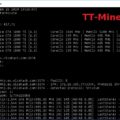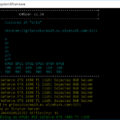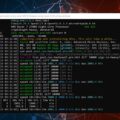
DOWNLOAD:
TT-Miner v3.2.0 (Nvidia GPU miner) – a program for video cards of the Nvidia family. Supports three hashing algorithms. It is mainly used for mining on the ProgPOW algorithm.
DevFee is 1% for all algorithms.
Changes in v3.2.0:
– support for Kadena (Blake2S) Pool / Solo
– SSL connection support
– command -cid / install Kadena ChainID
cid accepts one or more identifiers.
– command -tbr / set the time between two job requests. The default value is 8, which is 800 ms.
for efficiency – it’s better to set 900 ms.
Supported Algorithms:
- PROGPOW (BCI)
- PROGPOWZ (Zano)
- PROGPOW092 (HORA, Hydnora, Sero & Abassian)
- ETHASH (ETH, ETC, Music, Callisto, etc)
- UBQHASH (UBIQ)
- MTP (Zcoin)
- LYRA2REV3 (Vertcoin)
- EPIC (Epic Cash)
- EAGLESONG (CKB-Nervos)
- EAGLESONG (CKB-Nervos)
- BLAKE2S Blake2S (KDA-Kadena)
TT-Miner system requirements:
- Windows 7, 8.1 and 10 64-bit
- Nvidia Graphics Cards
- Nvidia driver version 411.31 or later
- May require Visual C ++ Redistributable Package for Visual Studio 2017 (64-bit)
Features of TT-Miner:
- Manage farms from a single computer
- Video Card Performance Monitoring
- Hashrate / sec performance rating
- Switching a farm or just one video card to other pools or another coin in a few seconds
- Low memory and processor power
- Supports CUDA 9.2 and CUDA 10.0
Setting TT-Miner
To quickly start cryptocurrency mining with TT-Miner, you need:
- Download program
- Unzip it to any convenient place (the miner is downloaded as a zip archive and does not require installation)
- Change wallet to your
After downloading the program, you will find ready-made examples of customized .bat files for mining and instructions in Russian.
For quick launch, just open the file with the .bat extension in any text editor and replace the wallet with your own. Below we will tell you how to do this, as well as how to more finely tune the program to your needs.
So, let’s start editing the batch file – we need to change the wallet address and configure some other parameters for your equipment. To do this, right-click on the .bat file and select the “Edit” item.
A text document opens with command line arguments. Consider what kind of teams are contained in our batch file.
Example of bat file:
Pool:
TT-Miner.exe -A BLAKE2S -coin kda -luck -log -logpool -P YOUR_WALLET.YOUR_WORKER@kda-us.icemining.ca:3700Solo:
TT-Miner.exe -A BLAKE2S -coin kda -luck -log -logpool -P https://YOUR_WALLET@NODE_SERVER:NODE_PORTDetailed configuration of batch file
TradeTec-MinerCmd.exe — indicate in the batch file which program we want to run. This file should be in the same folder as our batch file
PROGPOW-100 — specify the coin algorithm that we are going to mine
iN5h4sGcf1BD7R1mgaqkeGWnDvAubzyEKg
— after the construction -P stratum + tcp: // specify the address of our digital wallet. You can take it on the exchange where the coin is traded, or install a cold walletrig1 — after we entered the wallet address, put a dot and indicate the name of our farm. You can use any. This is necessary to track statistics on the pool.
bci-eu.coinblockers.com — after the @ sign we indicate the address of the pool.
- 3910 specifying the address of the pool, put a colon and indicate the port of the pool
—list-devices — the command will display all available mining devices
These are all the necessary commands to run the program. Below is an example with payfrom (payout mode). On some pools, you can adjust the frequency of payments. We have commented out this example with the REM team. If you remove this command, then example No. 2 will be used.
So we set up the program for the first launch. How to run it? The cryptocurrency mining process is launched by double-clicking on the created or edited batch file (file with the .bat extension). So, we launch and look at what the program console writes to us.
TradeTec-Miner — the program reports the installed version
Found 2 CUDA devices — two mining devices available
#0 PCI 0:1 GeForce GTX 1080 Ti (6.1) CoreClk 139 MHz | MemClk 495 MHz | 11264 MB | SM: 28 — the name of the video card, the overclocked core and memory, the available amount of video memory
bci-eu.coinblockers.com:3910 — the pool that we indicated in the batch file
iN5h4sGcf1BD7R1mgaqkeGWnDvAubzyEKg — address of the wallet to which the extracted coins will be sent
YOUR WORKER – farm name (optional)
Use algo: ProgPoW (Programmatic Proof-of-Work) — we specified the ProgPoW algorithm
- CUDA 10.0 — cuda architecture on which graphics cards work
Press ‘Q’ — to stop mining and terminate if you press the Q key in the active miner window, the program will close
Set nonce generation to mode: 3 — timeout: 0.00 secs. – nonce is set to mode 3. More on this below
Subscribed to bci-eu.coinbiockers.com:3910 — we were able to connect to the pool
Received new job#: d27a — pool sent a new job for video cards
Pool difficulty update: 0.08 GH — the pool set the difficulty to 0.08 GH. convenient power calculator you will find here
Worker authorized: YOUR WORKER — we logged in to the pool
create new DAG for epoch 6 — DAG file for mining is generated. Need to wait a bit
DAG created in 2.7 seconds — DAG file created in 2.7 seconds
Accepted 86 ms. bci-eu.coinbiockers.com:3910 — The pool made a decision (share) from our video card. The remuneration to the miners is paid precisely for the number of solved ball.
It takes the miner about 4-5 minutes until he shows a stable hash rate.
Here is a ready-made example of a batch file. You will find other examples in the article below.
@echo off :loop TradeTec-MinerCmd.exe -A PROGPOW-100 -P stratum+tcp://iN5h4sGcf1BD7R1mgaqkeGWnDvAubzyEKg.rig1@bci-eu.coinblockers.com:3910 --list-devices rem using payfrom on CoinBlockers rem TradeTec-MinerCmd.exe -A PROGPOW-100 -P stratum+tcp://iN5h4sGcf1BD7R1mgaqkeGWnDvAubzyEKg.rig1:payfrom=5@bci-eu.coinblockers.com:3910 --list-devices echo restart miner... goto loop
Consider all the possible commands supported by the program.
All command line arguments
Add new pool
-P specify the information for connecting to the pool in the format: -P scheme://user[.workername/username][:password]@hostname:port scheme:
stratum: uses stratum mining protocol
user: username or wallet address
workername: the name you want to assign to this farm, or the username for the login on the pool
password: password (if necessary)
hostname: hostname or IP of the pool
port: port used to connect to the pool
-A ALGONAME — choose the necessary algorithm for mining. There are no default values!
Available Algorithms:
- ETHASH-100 Ethash Algorithm for CUDA 10.0
- ETHASH-92 Ethash Algorithm for CUDA 9.2
- UBQHASH-100 Ubqhash algorithm for CUDA 10.0
- UBQHASH-92 Unqhash Algorithm for CUDA 9.2
- PROGPOW-100 ProgPoW algorithm for CUDA 10.0
- PROGPOW-92 ProgPoW algorithm for CUDA 9.2
CUDA Options:
*Note. If two parameters are specified, separated by commas, then you need to write only one of the parameters. These are synonyms.
-cbs, —cuda-block-size INT — Select the CUDA block size to use. Default is 512
-cgs, —cuda-grid-size INT — Select CUDA grid size when using. Default is 1024
-d, —cuda-devices INT — Select CUDA devices to use. By default, all devices found are used.
API monitoring and control options:
—api-bind IP[:port] — includes API monitoring programs for IP addresses. If you did not specify a port, then port 3333 is used by default
—api-password — provides access to the API with this password only
Common parameters:
-h, —help — show help and supported options
-V, —version — show program version
-v INT — select the amount of information displayed 0 – only errors and important information 1 – add warnings 2 – add useful information (default) 3 – add debug output
-U, -cuda — mining using CUDA devices
-list-devices — shows detected CUDA devices
-N INT INT —determines how the miner creates the Nonce parameter (a number that can be used once in cryptography)
The first value determines the way:
0 – do not reset; the miner will continue to increase the one-time number (Nonce) and it will never be reset
1 – reset the one-time number to zero
2 – Always create random nonces
3 – reset to a random one-time number for each new job – this is the default value
4 – reset to random nonce for each new task and after a timeout if no solution was found
the second value determines the timeout at the 10th second, use as in this example:
-N 0 0 never reset a one-time number
-N 4 75 reset to a random one-time number for any new job or if a new solution is not found in 7.5 seconds
-logpool creates a log file in the ‘Logs Miner’ subfolder containing pool connection information
Recommended Related Articles:













19 Comments So far